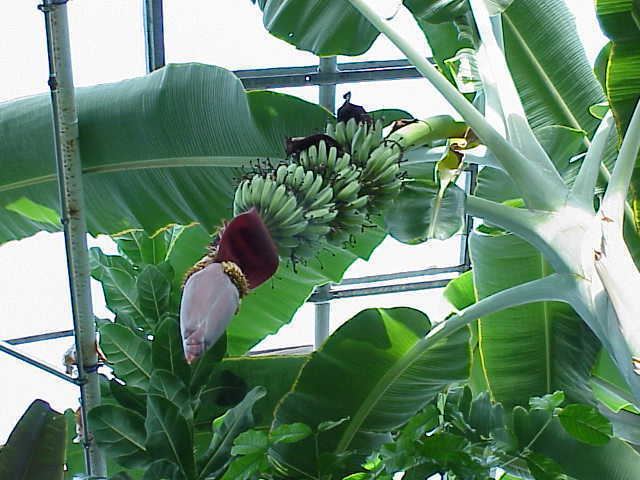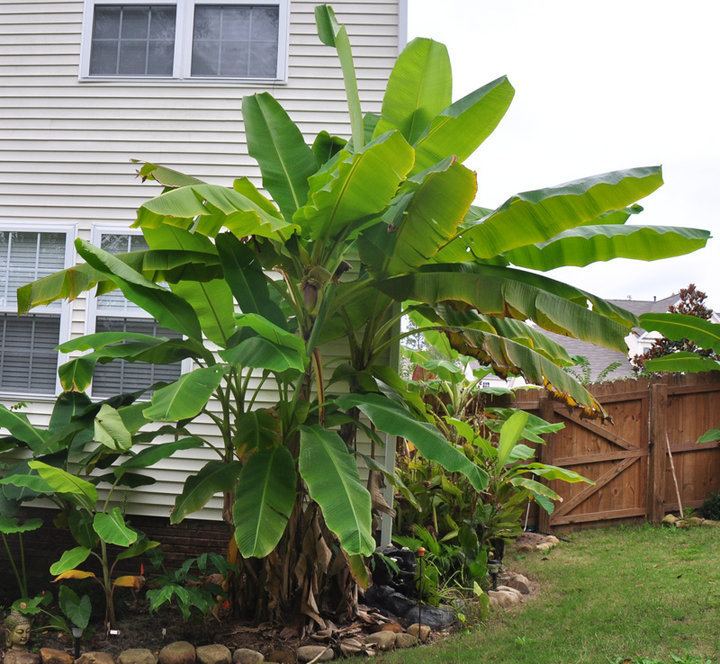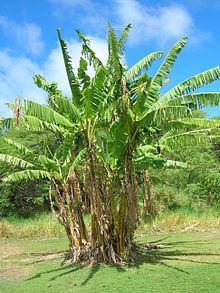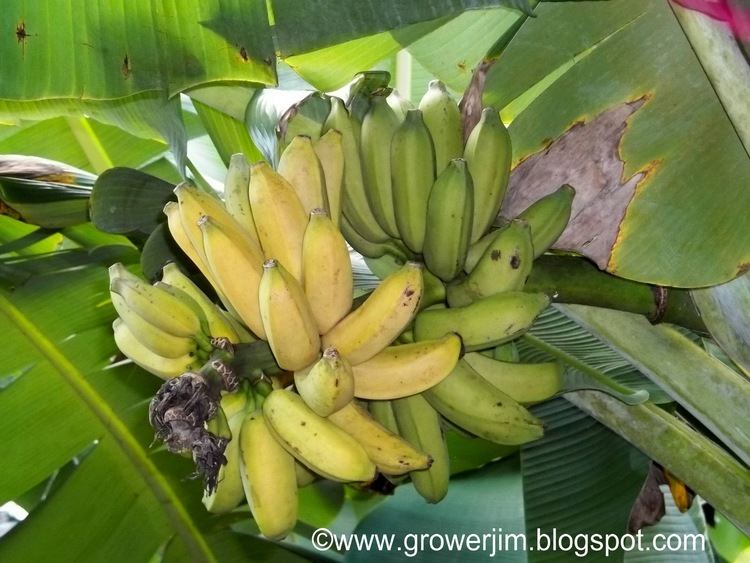Higher classification Banana | Scientific name Musa Rank Genus | |
 | ||
Lower classifications | ||
Harvesting a big bunch of bananas musa genus hd video
Musa is one of two or three genera in the family Musaceae; it includes bananas and plantains. Around 70 species of Musa are known, with a broad variety of uses.
Contents
- Harvesting a big bunch of bananas musa genus hd video
- History
- Sections
- Species
- Section Callimusa incorporating Australimusa
- Section Ingentimusa
- Section Musa incorporating Rhodochlamys
- Section undetermined or unknown
- Formerly placed here
- Cultivated bananas
- Section Musa cultivars
- Fei type cultivars
- References

Though they grow as high as trees, banana and plantain plants are not woody and their apparent "stem" is made up of the bases of the huge leaf stalks. Thus, they are technically gigantic herbs.

Musa species are used as food plants by the larvae of some Lepidoptera species, including the giant leopard moth and other Hypercompe species, including H. albescens (only recorded on Musa), H. eridanus, and H. icasia.
History
The genus Musa was first named by Carl Linnaeus in 1753. The name is a Latinization of the Arabic name for the fruit, mauz (موز). Mauz meaning Musa is discussed in the 11th-century Arabic encyclopedia The Canon of Medicine, which was translated to Latin in medieval times and well known in Europe. Muz is also the Turkish and Persian name for the fruit. Some sources assert that Musa is named for Antonius Musa, physician to the Emperor Augustus. The word "banana" came to English from Spanish and Portuguese, which in turn apparently obtained it from a West African language (possibly Wolof).

From the time of Linnaeus until the 1940s, different types of edible bananas and plantains were given Linnaean binomial names, such as Musa cavendishii, as if they were species. In fact, edible bananas have an extremely complicated origin involving hybridization, mutation, and finally selection by humans. Most edible bananas are seedless (parthenocarpic), hence sterile, so they are propagated vegetatively. The giving of species names to what are actually very complex, largely asexual, hybrids (mostly of two species of wild bananas, Musa acuminata and Musa balbisiana) led to endless confusion in banana botany. In the 1940s and 1950s, it became clear to botanists that the cultivated bananas and plantains could not usefully be assigned Linnean binomials, but were better given cultivar names.
Sections
Ernest Entwistle Cheesman carried out a major revision of the Musaceae in the 1940s. Following his approach, the genus Musa was divided into five sections: Ingentimusa, Australimusa, Callimusa, Musa, and Rhodochlamys. These were reduced to three in 2002. Previously, the 2n = 20-chromosome species were separated into the sections Australimusa and Callimusa and the 2n = 22-chromosome species were separated into the sections Musa and Rhodochlamys. Studies have shown that genetic differences between each section in the same chromosome group are smaller than those within each section. This means the traditional separation of the sections can no longer be substantiated. Wong's studies do, however, maintain the separation between the 20- and 22-chromosome species. At present, the 2n = 14 chromosome Ingentimusa section also remains distinct.
Species
The World Checklist of Selected Plant Families accepts 68 species and two primary hybrids, as of January 2013, which are listed below. The assignment to sections is based on GRIN (where this gives the species), regrouped according to Wong et al.
Section Callimusa (incorporating Australimusa)
[A] and [C] indicate known placement in the former sections Australimusa and Callimusa, respectively.
Section Ingentimusa
Section Musa (incorporating Rhodochlamys)
M acuminata ssp. zebrina [= M. sumatrana] – blood banana
Section undetermined or unknown
Formerly placed here
Cultivated bananas
A number of distinct groups of plants bearing edible fruit have been developed from species of Musa. In English, fruits which are sweet and used for dessert are usually called "bananas", whereas starchier varieties used for cooking are called "plantains", but these terms do not have any botanical significance. By far the largest and now the most widely distributed group of cultivated bananas is derived from section Musa, particularly M. acuminata and M. balbisiana, either alone or in various hybrid combinations. The next but much smaller group is derived from members of section Callimusa (previously classified as Australimusa) and is restricted in importance to Polynesia. Of even more restricted importance are small groups of hybrids from Papua New Guinea; a group from section Musa to which Musa schizocarpa has also contributed, and a group of hybrids between section Musa and section Callimusa.
Section Musa cultivars
When the Linnaean binomial system was abandoned for cultivated bananas, an alternate genome-based system for the nomenclature of edible bananas in section Musa was devised. Thus, the plant previously known by the "species" name Musa cavendishii became Musa (AAA Group) 'Dwarf Cavendish'. The "new" name shows clearly that 'Dwarf Cavendish' is a triploid, with three sets of chromosomes, all derived from Musa acuminata, which is designated by the letter "A". When Musa balbisiana is involved, the letter "B" is used to denote its genome. Thus, the cultivar 'Rajapuri' may be called Musa (AAB Group) 'Rajapuri'. 'Rajapuri' is also a triploid, expected to have two sets of chromosomes from Musa acuminata and one from Musa balbisiana. In the genome of edible bananas from section Musa, combinations such as AA, BB, ABB, BBB and even AAAB can be found.
For a more detailed explanation of this system and a list of some edible banana and plantain cultivars using it, see the List of banana cultivars.
Fe'i-type cultivars
No such nomenclature system has been developed for the group of edible bananas derived from section Callimusa. This group is known generally as the "Fe'i" or "Fehi" bananas, and numerous cultivars are found in the South Pacific region. They are very distinctive plants with upright fruit bunches, featuring in three of Paul Gauguin's paintings. The flesh can be cooked before eating and is bright orange, with a high level of beta carotene. Fe'i bananas are no longer very important for food, as imported foods have grown in popularity, although some have ritual significance. Investigations are under way to use the Fe'i karat bananas (the name derives from "carrot" due to the intense orange-yellow color of the fruit) in prevention of childhood blindness in Pohnpei. Fe'i bananas probably derive mainly from Musa maclayi, although their origins are not as well understood as the section Musa bananas. Cultivars can be formally named, as e.g. Musa (Fe'i Group) 'Utafun'.
